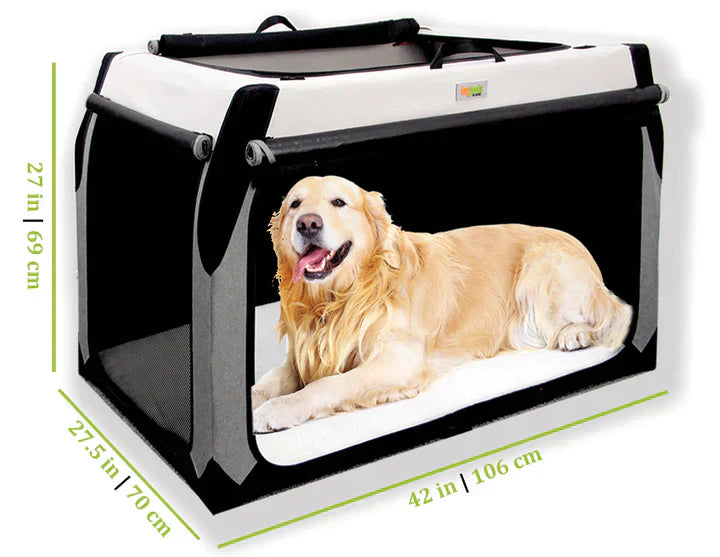Travel Dog Crate Size Guide: Find the Perfect Fit for Your Pup
Posted by Tamyres Lenes on
Picking the right crate size for your dog might seem straightforward, but it's trickier than you'd think. An ill-fitting crate can lead to discomfort or anxiety, so it's essential to choose wisely.
This guide will cover why proper sizing matters, how to measure your dog accurately, and standard size recommendations for different breeds. By the end, you'll be confident to select the perfect crate—including our collapsible, soft-sided options designed to accommodate everything from tiny pups to giant breeds. Our crates provide a secure, cozy space for your dog while remaining practical for you—easy to store, hassle-free to transport, and stress-free to use.
Key Takeaways
- The right crate size ensures your dog feels safe and comfortable
- Measure your dog accurately for a proper crate fit to avoid discomfort
- A crate that's too large can lead to indoor bathroom habits
- Choosing crates with adjustable dividers can accommodate your growing puppy's needs
- Use positive reinforcement to help your dog feel comfortable and secure in their crate
Understanding the Importance of Correct Crate Sizing
Choosing the right size for your dog's crate is crucial to its comfort and happiness. Explore our all-products section to find the perfect fit. A properly sized crate with a soft, breathable interior and controlled light intake prevents stress and anxiety, especially for breeds like the Siberian Husky, which are known for their energetic personalities.
Discover Doggoods Exclusive Foldable Dog Crate by clicking here.
When your dog feels safe and comfortable in their crate, they will adapt better to this space in your home.
For smaller breeds, like the Yorkshire Terrier, the correct crate size ensures they can rest without feeling overwhelmed. These cozy spaces help them feel safe, allowing for moments of calm in their daily lives. A well-fitting crate made from quality materials like wood can create a serene environment tailored to your dog's needs. Check out our blog updates for more tips and explore all products to find the perfect crate.
By understanding your dog's breed and personality and staying informed about dog behavior, you can choose a crate that promotes positive behaviors and creates a haven during walks, travel, and other activities:
Check out Doggoods blog updates for more tips.
The wrong size can lead to behavioral issues, as dogs may associate their crate with discomfort. If a crate is too large, they may use one end as a bathroom, disrupting their habits. By understanding your dog's breed and personality and staying informed through blog updates, you can choose a crate from all products that promote positive behaviors and create a haven:
- Measure your dog when standing, sitting, and lying down.
- Choose a size that allows your dog to stand and turn around comfortably.
- Consider a divider for growing puppies to maximize use.
Every dog is different, and their needs vary. Next, we'll find the right crate size for each breed, ensuring comfort and safety for your loyal companion.
Determining the Right Crate Size for Every Breed
Choosing the correct crate isn't just about picking a size—it's about understanding your dog's unique needs. Factors like height, weight, and breed characteristics ensure a proper fit. For instance, high-energy breeds like Cattle Dogs may need a crate with extra durability, while a Welsh Corgi's long body requires ample space to stretch comfortably.
Beyond size, your dog's behavior and habits matter, too. Smaller breeds like Russell Terriers, known for their curious and active nature, may benefit from a cozy yet breathable crate that provides security without feeling restrictive. Similarly, puppies or growing dogs may require an adjustable crate with dividers to accommodate their changing size.
In this section, we'll explain everything you need to know to select a crate that perfectly suits your dog—from measuring tips to breed-specific recommendations—ensuring comfort, safety, and peace of mind for both you and your pup.
Overview of Dog Sizes and Breeds
Choosing the Perfect Crate for Your Dog
Selecting the right crate isn't just about size; it's about ensuring your dog's comfort, safety, and convenience. Different breeds, like the agile Parson Russell Terrier or the energetic Australian Cattle Dog, have specific needs. Hence, it is crucial to choose dimensions that allow them to move freely without feeling confined.
When shopping for a crate, consider more than just durability. While metal crates are strong, they're often heavy, uncomfortable, and take up too much space in your car or home, making them impractical for everyday use. Plastic crates are lighter but still bulky, limiting storage flexibility and portability.
That's why pet owners love our Foldable Dog Crate, designed with convenience and comfort in mind. Available in multiple sizes, it's lightweight, breathable, washable, and folds flat when not in use, making storage effortless. Its soft yet durable structure provides a cozy retreat for your dog without compromising support.
No matter where you're headed, whether on a road trip, in an airplane or for a quick vet visit, this crate is a must-have for pet owners who prioritize both comfort and practicality.
Learn more here and find the perfect fit for your furry companion!
Factors That Influence Crate Size Selection
Standard Dog Crate Size Guidelines
Selecting the right crate for your dog starts with understanding size recommendations based on breed categories. You'll explore size definitions—small, medium, large, and extra-large—tailored to specific breeds, whether it's a towering Great Dane or an energetic Spaniel.
Consider your dog's weight and height to ensure a comfortable fit. The right crate provides a cozy space where your furry friend feels safe and at home.
This section will guide you through choosing a crate that meets your dog's unique needs, covering essential size recommendations and key factors influencing your decision.
Dog Crate Size Recommendations Based on Breed Categories
Your dog's breed plays a crucial role in crate selection. For instance, a Labrador Retriever needs enough space to stretch out, while a King Charles Spaniel may feel more secure in a snugger environment.
Choosing a crate that matches your dog's size and natural behaviors is essential. Dogs often use their noses to explore their surroundings, and a properly sized crate enhances their sense of security—whether they're enjoying a meal or resting after playtime.
Explore our detailed foldable crate size guide to find the perfect fit for your dog's breed and needs.
Common Mistakes to Avoid When Measuring Your Dog For The Perfect Dog Crate
When measuring your dog for the perfect crate fit, it's easy to make some common errors that can lead to discomfort later on.
For instance, skipping the height measurement can mean a cramped space, while not considering their tail length may result in a too-short crate.
To avoid these pitfalls, always double-check your measurements, and remember that taking a little extra time can help you find the right crate for your dog, ensuring that it feels secure and happy in its new space.
Adjusting Dog Crates for Growth in Puppies
When you bring a puppy into your home, you'll want to consider their size as they grow. Puppies can change rapidly, so adjust your crate choice accordingly to accommodate their growth spurts. Consider using a crate with a divider, which allows you to create a snug space for your puppy while giving them room to stretch as they grow, ensuring they feel comfortable and secure throughout their development:
- Start with a smaller space for your young pup.
- Use a divider to expand the crate as it gets larger.
- Regularly check their size and make adjustments as needed.
Now that you know how to find the right size crate, consider this: some dogs need more than standard options. Custom crates can perfectly fit unique breeds, enhancing comfort and safety.
Frequently Asked Questions About Dog Crate Sizing
What to Do if My Dog Refuses to Enter the Crate?
If your dog refuses to enter the crate, start by making it a more welcoming place for them. Try placing their favorite blanket or toys inside to create a cozy environment that sparks their curiosity. Patience is key—encourage them to explore the crate at their own pace, rewarding them with praise or treats when they do. Over time, this positive reinforcement can help build their confidence and make the crate a familiar, safe space in your home.
How to Create a Positive Crate Experience for My Dog?
To create a positive crate experience for your dog, start by making the crate a fun and inviting space. You can include your dog's favorite blanket or toys inside to create a cozy and safe environment.
Please encourage them to explore by leaving the crate door open during the day and reward them with treats or praise when they show interest. This gentle approach helps your dog associate the crate with comfort and security, making it a place they enjoy visiting.
Signs That the Crate Size Is Inappropriate for My Dog
If your dog seems anxious or refuses to enter the crate, it might be a sign that the size isn't quite right for it. Look for behaviors like whining, scratching, or avoiding the crate altogether, which often indicate discomfort or stress. Alternatively, if your pup has started using one end of the crate as a bathroom, that's a clear red flag that the space is too big and feels less secure.
Conclusion
Selecting the correct crate size for your dog is essential for their comfort and overall well-being. Proper sizing helps prevent anxiety and promotes positive behaviors, creating a safe environment for each breed. Please measure your dog accurately and consider their growth to ensure a snug fit, especially for puppies. Making informed choices about crate sizing enriches your dog's life, allowing them to feel secure and happy in their space.



 Verified Purchase
Verified Purchase
 Catalog
Catalog
